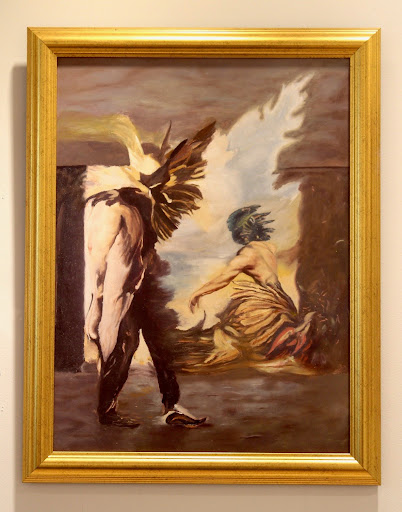“Why are there monks in the Caf?”
Guilford College’s campus was abuzz with this question last week when serene men in traditional maroon robes were spotted by curious students.
Six Tibetan Buddhist monks spent Oct. 28–31 constructing a sand mandala in the Dana Auditorium lobby.
Before laying down the sand, the monks drew the geometric measurements associated with the mandala. They then applied tiny sand granules using metal tools called chak-pur that created a meditative, whirring sound. The monks created one section of the diagram at a time, working from the center outwards.
“The mandala has to be exact,” said junior Sophie Laine, a member of Guilford’s Buddhist Fellowship Club. “You can’t just mess up part of it and say, ‘Oh, it doesn’t matter, we’ll wipe it away anyway later,’ because if it’s not correct then it won’t invoke the deity.”
The final product was a vividly colored, organized design that attracted the eyes of anyone who set foot in the lobby.
“A mandala itself is like a celestial palace that a Buddha lives in,” said Visiting Instructor of Justice and Policy Studies Daniel Rhodes. “They did the mandala of the compassion Buddha.”
The monks traveled from Sera Je school and monastery in India. Their visit promotes Free Tibet, a movement to end the Chinese occupation of Tibet.
“What is surprising to many people outside Tibet is that the situation continues to deteriorate,” said Associate Professor of Religious Studies Eric Mortensen. “Tibetans are not able to freely practice their religion. Over the past few years, at least 127 Tibetans have self-immolated due to the repressive policies of China toward Tibetans.”
The Buddhist Fellowship club, which helped organize the monks’ visit to campus, focuses on nonviolent practices.
“Buddhism is about loving everyone no matter what,” said senior Daphne Hankins, a member of the Fellowship. “Absolute acceptance no matter what their background is, no matter what their age or race. Everyone is equal and everyone can teach you a lesson. And you should endeavor to love equally.”
The final ceremony of the event required the destruction of the mandala. The monks carefully gathered some of the sand and handed it out in little bags to spectators.
They then took the remaining grains of the mandala down to the lake and slowly poured the residual colored sand into the water. This tradition symbolizes the transitory nature of the world.
“Everything is impermanent,” said Geshe Sangpo, a highly esteemed monk from Sera Je Monastery. “No attachment. This is showing Tibet culture.”
[photomosaic nggid=172]











Susan • Dec 19, 2013 at 11:58 pm
THIS IS THE BEST THING YOU’VE EVER DONE. I KNOW THIS. OBVIOUSLY.
Carol Nickle • Dec 1, 2013 at 3:00 pm
This is beautiful and powerful, and I learned new facts and new dimensions.